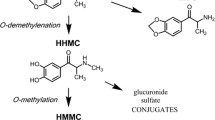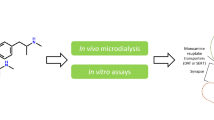Abstract
The importance of hepatic metabolism in relation to the central (dopaminergic) effects of piribedil (PD) is still not really known. Plasma and brain kinetics and the effects on striatal dopamine (DA) metabolism of the parent drug and its known metabolites were therefore evaluated in rats, a species widely used in neurochemical studies of this drug. PD injected intraperitoneally (IP, 15–60 mg/kg) and centrally (ICV, 100–200 µg/rat) lowered striatal 3,4-dihydroxyphenylacetic acid (DOPAC) and 3-methoxy-4-hydroxyphenylacetic acid (HVA) content and the intensity and time-course of the neurochemical effects were route- and dose-relatedly dependent on brain PD kinetics. The catechol (M1), p-hydroxylated (M2) and N-oxide (M3) metabolites of the drug were detectable only in trace amounts in rat brain and only at the highest IP dose tested; when administered ICV at doses equimolar to PD they caused no decrease in striatal DA metabolites, although striatal concentrations were higher than after IP PD, being comparable to or higher than those of the ICV parent drug. These data suggest that metabolites do not contribute to the dopaminergic effects of PD in rats.
Similar content being viewed by others
References
Achilli G, Perego C, Ponzio F (1985) Application of the dual-cell coulometric detector. A method for assaying monoamines and their metabolites. Anal Biochem 148:1–9
Caccia S, Fong MH, Guiso G (1985) Disposition of the psychotropic drugs buspirone, MJ-13805 and piribedil, and of their common active metabolite 1-(2-pyrimidinyl)-piperazine in the rat. Xenobiotica 15:835–844
Corrodi H, Farnebo L-O, Fuxe K, Hamberger B, Ungerstedt U (1972) ET 495 and brain catecholamine mechanisms. Evidence for stimulation of dopamine receptors. Eur J Pharmacol 20:195–204
Costall, B, Naylor RJ (1973) The site and mode of action of ET 495 for the mediation of stereotyped behaviour in the rat. Naunyn Schmiedebergs Arch Pharmacol 278:117–133
Costall B, Naylor RJ (1974) Dopamine agonist and antagonist activities of piribedil (ET 495) and its metabolites. Naunyn Schmiedebergs Arch Pharmacol 285:71–81
Creese I (1974) Behavioural evidence of dopamine receptor stimulation by piribedil (ET 495) and its metabolite S584. Eur J Pharmacol 28:55–58
Dourish CT (1983) Piribedil: Behavioural, neurochemical and clinical profile of a dopamine agonist. Prog Neuropsychopharmacol Biol Psychiatry 7:3–27
Fanelli R, Frigerio A, Garattini S (1975) Levels of piribedil and its active metabolite (S-584) in the rat striatum. Xenobiotica 5:595–600
Gibaldi M, Perrier D (1982) Pharmacokinetics, 2nd edn. Marcel Dekker, New York
Glowinsky J, Iversen LL (1966) Regional studies of catecholamines in the rat brain. I. The disposition of [3H]norepinephrine, [3H]dopamine and [3H]dopa in various regions of the brain. J Neurochem 13:655–669
Goldstein M, Anagnoste B, Shirron C (1973) The effect of trivastal, haloperidol and dibutyryl cyclic AMP on [14]dopamine synthesis in rat striatum. J Pharm Pharmacol 25:348–351
Jenner P, Taylor AR, Campbell DB (1973) Preliminary investigation of the metabolism of piribedil (ET 495); a new central dopaminergic agonist and potential anti-parkinson agent. J Pharm Pharmacol 25:749–750
Jori A, Cecchetti G, Dolfini E, Monti E, Garattini S (1974) Effect of piribedil and one of its metabolites on the concentration of the homovanillic acid in the rat brain. Eur J Pharmacol 27:245–248
Kebabian JW, Calne DB (1979) Multiple receptors for dopamine. Nature 277:93–96
Lukas G, Brindle SD, Greengard P (1971) The route of absorption of intraperitoneally administered compounds. J Pharmacol Exp Ther 178:562–566
Miller RJ, Iversen LL (1974) Stimulation of a dopamine-sensitive adenylate cyclase in homogenates of rat striatum by a metabolite of piribedil (ET 495). Naunyn Schmiedebergs Arch Pharmacol 282:213–216
Noble EP, Wurtman RJ, Axelrod J (1967) A simple and rapid method for injecting H3-norepinephrine into the lateral ventricle of the rat brain. Life Sci 6:281–291
Sarati S, Guiso G, Spinelli R, Caccia S (1991) Determination of piribedil and its basic metabolites in plasma by high-performance liquid chromatography. J Chromatogr 563:323–332
Author information
Authors and Affiliations
Rights and permissions
About this article
Cite this article
Sarati, S., Guiso, G., Garattini, S. et al. Kinetics of piribedil and effects on dopamine metabolism: hepatic biotransformation is not a determinant of its dopaminergic action in rats. Psychopharmacology 105, 541–545 (1991). https://doi.org/10.1007/BF02244377
Received:
Revised:
Issue Date:
DOI: https://doi.org/10.1007/BF02244377




